 Today football enthusiasts are everywhere around the world. This enthusiam is just like an illness for some of us. There are many people (especially my boy friend) planning their weekends according to the hours of matches. Even the rest of weekend can be on the verge of disaster due to the bad result which spoils enthusiast’s good mood. Therefore, the importance of branding in sports cannot be ignored.
Today football enthusiasts are everywhere around the world. This enthusiam is just like an illness for some of us. There are many people (especially my boy friend) planning their weekends according to the hours of matches. Even the rest of weekend can be on the verge of disaster due to the bad result which spoils enthusiast’s good mood. Therefore, the importance of branding in sports cannot be ignored.
Like one of Turkish writers puts into the words; probably, club managers did not realise or handle this branding approach. Because they generally became champion once in every three years with their traditional management style, otherwise they accused of referees or dismissed the coach. They regarded marketing as selling of licenced products. For years, in media everybody was telling stories about brand value, however nobody understood what was told. There was nobody guiding or leading by example.
As Anatolian teams of Turkey realised this tendency in branding and started to take an action, raising the bar has become inevitable for “Elders”, in other words, big teams. So these suggestions below will more likely attract attention. I am writing what should be done step by step by quoting from Güven Borça:
1) First of all, we will make a comprehensive research: Who we are, what we are, how we differentiate ourselves, what basic values and motivations that differentiate us from our competitors we have. So we will develop propositions in order to increase emotional motivation of fans.
2) How wide are our scope of activities; in which sports branches what kind of local and global aims should we have? Whether we will take all of us or focus on certain scopes? Which consumer group will we cover in branches we focused on? Then in which event will we take place? Whether we will have TV, radio, store, restaurant and hotel or not? In which products will we allow licence usage and why?
3) Who is our core target audience? Who will we bring to the matches, who will we reach by television, internet, mobile phone? In which channel what message will we give? Who will we sell goods? How many people are they?
4) What are our foreign branding and communication aims? Will there global aims and touching points in our positioning? In Muslim world, Asia, Balkans do we have specific aims and how will we organize?
5) What are our commitment, message, identity, character? We will discuss at length and put into documents like Markod. We will share these strategic documents with all business partners, organize trainings and try to internalize them.
6) We will hold a consultation with technical team to form a team which is appropriate for our brand style. Even we will result in hiring of a coach who is appropriate for our brand style. Will ambition or fun stick out, individualism or sharing?
7) We will develop visual identity, logo, emblem, symbols. We will design new uniforms by working together with important designers of the country. We will revise logos, symbols if it is needed. We will try alternative colours and get rid of commonness.

8) We will develop slogan, music, expressions. We will forestall abusive language. Our expressions will be appropriate for our brand commitment.
9) We will determine communication points and spokesmen. We will identify key spokesmen and plan communication around them.
10) We will dress our bus, stadium, training field, press conference room according to brand identity. Not only club colours but also symbols, expressions will be emphasized.

11) We will work together with professional business partners in implementation.We will have regular advertising agency, PR company and media planning company.
12) We will establish a professional team that is responsible for the brand. This team will work not only to sell licensed products and tickets but also to protect brand values and implement them. All branding issues will be worked and submitted for the administration by this team.
13) We will employ coaches, image makers, psychologists for football players. We will teach them to dress, speak, pose.
14) We will make fan trainings. We will organize fan groups and make brand activities. Together with them, we will plan brand architecture.
15) Professionally, we will manage media relations. We won’t establish a relationship out of personal relations of president and love/hate.
And all of these won’t exceed the cost of a middle football player you’ve hired this year.
 P&G had used Woods, Roger Federer and dozens of other athletes as part of its “Gillette Champions” marketing campaign. Gillette, which plans to phase out its champions marketing program in the first quarter of 2011, will not renew its endorsement contract with golfer Tiger Woods. The endorsement is reported to end on the 31 December as a consequence of which Procter & Gamble will be terminating its Champions marketing campaign. The campaign was scheduled for the first cut up of the upcoming New Year.
P&G had used Woods, Roger Federer and dozens of other athletes as part of its “Gillette Champions” marketing campaign. Gillette, which plans to phase out its champions marketing program in the first quarter of 2011, will not renew its endorsement contract with golfer Tiger Woods. The endorsement is reported to end on the 31 December as a consequence of which Procter & Gamble will be terminating its Champions marketing campaign. The campaign was scheduled for the first cut up of the upcoming New Year. Gillette said, “His contract ran its full term like many other athletes that were part of the Champions program. We are ending the Gillette Champions program after three years. Like any brand, we refresh our marketing efforts to ensure they continue to be relevant for our consumers.”
Gillette said, “His contract ran its full term like many other athletes that were part of the Champions program. We are ending the Gillette Champions program after three years. Like any brand, we refresh our marketing efforts to ensure they continue to be relevant for our consumers.”






























